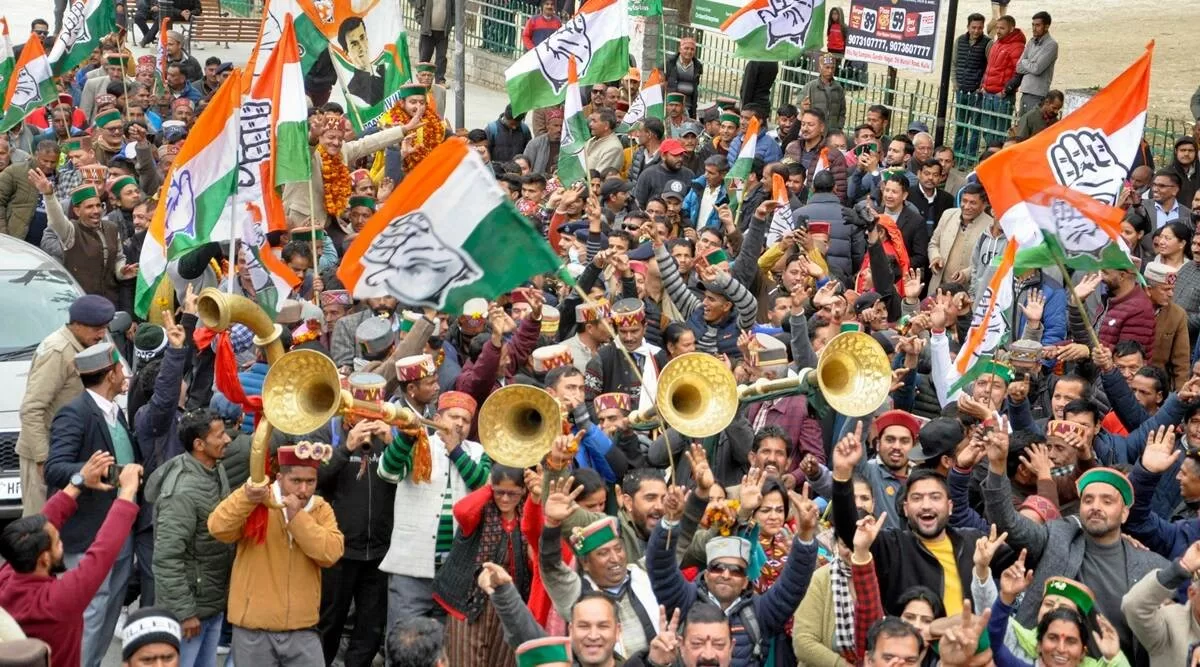Congress supporter celebrates party’s win on the counting day of the Himachal Pradesh Assembly elections, in Kullu, Thursday, Dec. 8, 2022. (PTI Photo)
P Chidambaram writes: The elections hold lessons for both winners and losers. The common lesson is that the winner had a strong party organisation, dedicated cadres, a spirited campaign and micro-management.
Written by P Chidambaram
Updated: December 11, 2022 7:55:17 am
In many elections in the past, incumbency was considered a millstone around a party’s neck. After the dominant Congress era ended in 1967, several governments in the states were defeated and, led by regional parties, non-Congress parties came to power. The era of non-Congress governments at the Centre began in 1977.
The saga of alternating governments started in Kerala. Since the 1990s, we have seen alternating governments in Rajasthan, Himachal Pradesh, Uttar Pradesh, Madhya Pradesh, Bihar, Andhra Pradesh, Karnataka and Tamil Nadu.
Defying Incumbency
However, there have been examples of tall leaders defying incumbency. M G Ramachandran and his party, the AIADMK, won three elections in a row from 1977 in Tamil Nadu until his death in 1987. J Jayalalithaa and her party, the AIADMK, won three successive elections in Tamil Nadu in 2011, 2016 and 2021. Mr Naveen Patnaik and his party, the BJD, have won five successive elections since 2000. The most spectacular — and daunting — example has been the BJP that has won six successive elections in Gujarat since 1998 (and since 2002 under the leadership of Mr Narendra Modi as chief minister or as the de facto leader).
It appears that in certain situations and under certain leaders, incumbency has turned out to be a strength than a weakness. This phenomenon requires careful analysis by political observers, social psychologists and psephologists.
My prima facie observations are the following:
1. Parties which are in government amass a huge election war-chest during the five years in government, a thing unheard of when tall leaders like K Kamaraj, S Nijalingappa, K Brahmananda Reddy, E M S Namboodripad, Hitendra Desai, Y B Chavan, M L Sukhadia or Jyoti Basu (among others) were in power.
2. Ruling parties do not hesitate to politicise the bureaucracy, especially the police forces. Nowhere is it more visible than in Gujarat and Uttar Pradesh. In the recent by-election in Rampur Assembly constituency, the polling percentage was approx. 32 per cent while in Khatauli Assembly constituency of the same state the percentage was approx. 56 per cent. In the Mainpuri LS constituency, the percentage was approx. 53 per cent. The Samajwadi Party has alleged that the low voting in Rampur was mainly attributable to the role of the police.
Adding Technology, Muscle
3. Clever and far-sighted political parties have used technology extensively to strengthen and fine-tune their organisation. The BJP, and a few other parties, have been able to constitute booth committees to micro-manage the elections, especially on polling day. The BJP has been able to take micro-management to the level of management of the voters on each page of the electoral roll.
4. Ruling parties that have a well-structured party organisation add ‘muscle’ to the organisation. In the run-up to the elections, defectors from other parties, including serving legislators and notorious musclemen, are enticed to cross over to the ruling party. Money is an undoubted enticement. More than money, it is the ‘amnesty’ offered in respect of on-going investigations into crimes that does the trick. Suddenly, all investigations by the agencies stop in the case of a defector to the ruling party.
5. In the last few years, the ruling party has used religion as a polarising factor. This is done in many ways, some brazen and some subtle. For example, the BJP did not nominate any candidate from the Muslim community in the elections in Gujarat (2012, 2017 and 2022) and in Uttar Pradesh (2022) although Muslims constitute 9.7 per cent of the population of Gujarat and 20 per cent of Uttar Pradesh. The refusal to nominate a Muslim candidate sends a signal to the other communities and inevitably polarizes the electorate.
6. The failure of governance of the ruling party is sought to be drowned by a high-decibel campaign that is magnified manifold by a frightened — and also fawning — media. An independent media is a thing of the past. Practically, all media outlets (TV and newspapers) are owned and controlled by corporates. The social media is relatively free but is swamped by fake news, fake videos, trolls and bots.
Winners Can Lose
Besides the above, I am sure there are other factors at the level of the larger society that are unique to the history and culture of each state. In my view, a strange peace and silence has descended on Gujarat and Uttar Pradesh. Is it, as John Kennedy observed presciently, “the peace of the grave and the silence of the slave”? I sincerely hope it is not so. Dissent is suppressed by the State and practically blanked out by the media. If these trends lead to an eerie silence and peace, it will mean that we are hastening the day when India will be an electoral democracy but not a Constitutional democracy.
The recently concluded elections hold lessons for both winners and losers. The common lesson is that the winner had a strong party organisation, dedicated cadres, a spirited campaign and micro-management. In Gujarat, the BJP alone had all four factors going in its favour and defied incumbency. On the contrary, the principal challenger in Himachal Pradesh (Congress) and Delhi Corporation (AAP) had all four factors going in its favour and incumbency proved fatal.
Irrespective of the political party that won or lost, the victory of three parties in three elections are like the rays of sunshine amidst growing darkness.
© The Indian Express (P) Ltd
